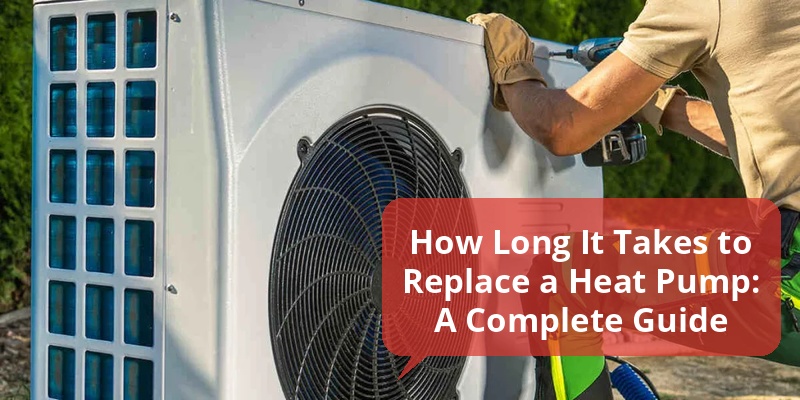Replacing a heat pump is a significant home improvement that involves careful planning and professional expertise. The duration of this process varies depending on several factors such as the type of heat pump, the complexity of installation, and the existing system setup. Typically, a heat pump replacement takes anywhere from one to three days, including removal, installation, and testing. This article explores every aspect influencing the timeline to help homeowners better prepare for their replacement project.
| Replacement Stage | Estimated Duration | Key Considerations |
|---|---|---|
| Old Unit Removal | 2 – 4 Hours | Depends on system accessibility and disposal requirements |
| New Heat Pump Installation | 4 – 12 Hours | Varies by unit size, type, and complexity |
| System Testing and Calibration | 1 – 3 Hours | Ensures optimal operation and efficiency |
| Total Project Time | 1 – 3 Days | Depends on factors detailed below |
Factors Influencing Heat Pump Replacement Time
The exact length of time it takes to replace a heat pump depends on a variety of factors. Understanding these can help homeowners set realistic expectations for the project timeline.
Type and Size of Heat Pump
Different heat pump systems, such as air-source, ground-source (geothermal), or ductless mini-split units, require varying installation efforts. Air-source heat pumps typically take less time to replace due to simpler ductwork or line set connections compared to geothermal systems, which require extensive groundwork and piping.
Condition and Complexity of Existing System
The age and condition of the current heat pump, ductwork, and electrical systems impact replacement speed. If ductwork or electrical wiring needs repair or upgrading, the process will extend correspondingly. Homeowners with well-maintained existing systems often experience faster replacements.
Permitting and Inspections
Local building codes may require permits and inspections before, during, or after heat pump installation. While this process can overlap with installation phases, delays in approvals can extend the overall timeline by days or weeks.
Installer Experience and Crew Size
The expertise of HVAC contractors and the number of technicians working on site greatly affects efficiency. Experienced installers who specialize in heat pumps tend to complete replacements faster and with fewer complications.
Step-by-Step Process of Heat Pump Replacement
Replacing a heat pump involves a series of coordinated steps. Each phase contributes to the overall project duration.
1. Pre-Installation Assessment and Planning
Prior to replacement day, an HVAC professional conducts a site survey, selects the appropriate heat pump size and type, and makes necessary arrangements. This phase ensures a smoother installation process and can take a few days to complete depending on scheduling.
2. Old Heat Pump Removal
The removal of the existing heat pump includes disconnecting electrical wiring, refrigerant recovery, detaching ductwork or line sets, and physically removing the unit. This step usually takes between 2 to 4 hours, with additional time if hazardous refrigerants require special handling.
3. New Heat Pump Installation
Installing the new unit involves positioning the heat pump, connecting electrical and refrigerant lines, and integrating the system with existing ductwork or installing new components if necessary. Complex installations may require modifications to the home’s infrastructure, extending installation time. This phase can range from 4 to 12 hours or more.
4. System Charging and Testing
Once installed, the system is charged with refrigerant and subjected to thorough testing for leaks, airflow, and thermostat integration. Proper calibration ensures energy efficiency and reliable performance. This final step usually takes 1 to 3 hours.
Common Challenges That Can Prolong Heat Pump Replacement
Understanding potential issues can help homeowners anticipate delays.
- Refrigerant Handling: Older units may use outdated refrigerants requiring special recovery and disposal procedures.
- Ductwork Upgrades: Leaky or poorly sized ducts must often be repaired or replaced to ensure heat pump efficiency.
- Electrical Updates: Heat pump systems often require dedicated circuits or upgraded panel capacity.
- Weather Conditions: Installation teams may face weather delays, especially with outdoor components.
Tips for a Smooth and Timely Heat Pump Replacement
- Choose Experienced Contractors: Select HVAC professionals specializing in heat pump systems with verifiable credentials.
- Prepare Site in Advance: Clear installation areas and ensure easy access to the existing system.
- Schedule Permits Early: Start the permitting process as soon as possible to avoid unexpected holdups.
- Communicate Expectations: Discuss estimated timelines upfront with your installer and confirm any contingencies.
Cost Implications Related to Replacement Duration
Project timelines influence labor costs and overall expenses. Quick replacements by skilled teams generally cost less in labor but may have higher upfront fees for expertise. Extended replacements caused by complications or necessary upgrades can increase total costs.
| Replacement Time | Average Labor Cost Range | Impact |
|---|---|---|
| 1 Day | $500 – $1,200 | Lower labor cost, minimal disruption |
| 2 Days | $1,200 – $2,000 | Moderate labor with possible system adjustments |
| 3+ Days | $2,000 and up | Higher labor due to system upgrades or complications |
When to Consider Professional Inspection Before Replacement
Homeowners unsure about their current heat pump’s status benefit from a professional inspection to evaluate system efficiency and identify necessary improvements. This can optimize replacement planning and reduce surprises during installation.
Innovations and Trends Affecting Heat Pump Installation Time
Recent advances like modular heat pump units, smarter diagnostic tools, and improved refrigerants have made installations quicker and more reliable. Contractors equipped with the latest technology can often streamline replacement timelines.
